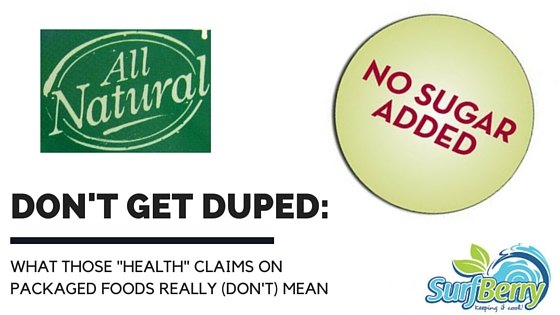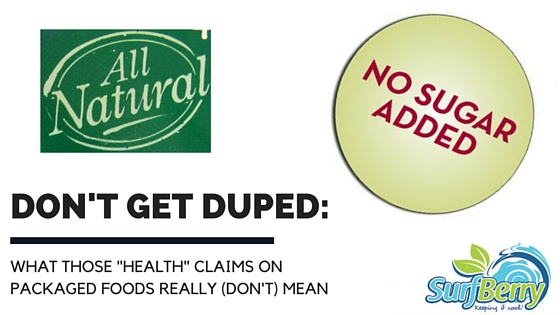
First of all, I want to be clear that I strive to eat a lot of actual foods that don’t require fancy packaging and nutrition and ingredients labeling, like real vegetables, fruits, locally and responsibly raised eggs and meats. If it doesn’t require a nutrition label or ingredients list, it’s likely to be a healthier choice. But it’s simply not realistic for my family–or most of you, I’m guessing–to avoid buying products that require actual packaging. And that’s what this post is about: not getting duped by the health hype plastered across the front of food product packaging.
I have a habit of which I’m quite proud, but drives my husband bonkers at times (like when we are in a bit of a hurry). When grocery shopping, I automatically flip a product over to read the BACK of the label and check out the actual ingredients. What often follows this act is an immediate eye roll and placement of the product back on the shelf. It’s become so automatic for me. I absolutely disregard the front of the label because I know these are the marketing claims conjured up by some advertising agency to help their client sell a specific brand to their target audience. I know this, because in my past life I helped do similar work for the pharma / biotech industry. Emphasis on “past life” part of that statement.
Here are a few common claims that often sound great to us, but are really just marketing gimmicks that are way more hype than health.
- “All natural”, as in “all natural” chicken, beef, whatever animal protein you’re thinking of purchasing. This term means absolutely NOTHING. Manufacturers can slap this claim on whatever they want, and it can mean whatever they want it to mean. When talking about animal proteins, like poultry, pork, and beef, the vast majority of animals raised in the United States are factory-farmed in the most UNnatural conditions imaginable. For example, factory-farmed chickens share a battery cage (about the size of an iPad) with 3 to 11 other chickens, and don’t see the light of day. Not exactly how Nature intended.
- “No added sugar”. This claim sounds pretty straight-forward and healthy, right? But it’s sneaky. Next time you think about buying a pre-bottled, manufactured green drink, turn that bad boy over and look at the ingredients, the number of servings, and the actual grams of sugar in each serving. It doesn’t take a lot of “green” to make the product LOOK healthy. You’ll find that many pre-packaged green drinks on the market contain mostly apple juice or fruit puree, and then maybe the 9th or 10th ingredient is an actual green vegetable, but not a very meaningful amount. As of right now, the FDA doesn’t consider fruit juices or purees as “added sugar”, even though these ingredients cause a serious spike in your blood sugar. But maybe the product really does have “no added sugar”, but guess what? It may have artificial sweeteners to replace the sugar. In many low-sugar products, Splenda (aka sucralose) is added. Artificial sweeteners remain controversial among health experts, but there’s enough evidence there to convince me that they are NOT a good idea. Potentially neurotoxic, and also tend to magnify a sweet tooth rather than help people reduce sugar intake
- “Multigrain”: this means that the product contains more than one type of grain, and none of them may actually be whole grains. Flip the product over, and you’ll likely see that the first (key) ingredients are refined flour (ie, straight to sugar in the body), and other highly processed, unnatural ingredients. In other words, not a health-food by any stretch of the imagination. In a similar vein, “made with whole grains” means just that. There may be some whole grains in there, but they may or may not be the main ingredients. Again, you’ll likely see lots of processed stuff in there, NOT a real food with real nutrients.
- “Low-fat” or “Non-fat”. Geez, I can’t believe these things are still dominating the shelves. It seems that the message is FINALLY getting out that fat is not enemy #1. But I still have to look really hard for normal yogurt because it’s buried among 48,000 different types of no-fat, non-fat, 0% formulations. Very often, when you look at the back of that non-fat yogurt label, you’ll see lots of sugar! This is true for other food products that would naturally contain fat, but have had the fat removed to make it “healthier”. They have to add SOMETHING in to make it palatable with less fat, and often that means sugar or other undesirable additives. This being said, there are certain TYPES of fat (mostly man-made, of course), that are not healthy. And guess what? they are exactly the types of fat found in most packaged, processed foods!!!
Bottom-line: you have to be your own food detective. Sad but true. If it requires a wrapper or container, if it has a “brand”, turn it over and scan the nutrition label and ingredients. For the next post, I’ll give you some easy tips for how to quickly determine if a product is worth your health and money.


 RENTALS
RENTALS ACTIVITIES
ACTIVITIES Menu
Menu ABOUT
ABOUT CONTACT
CONTACT